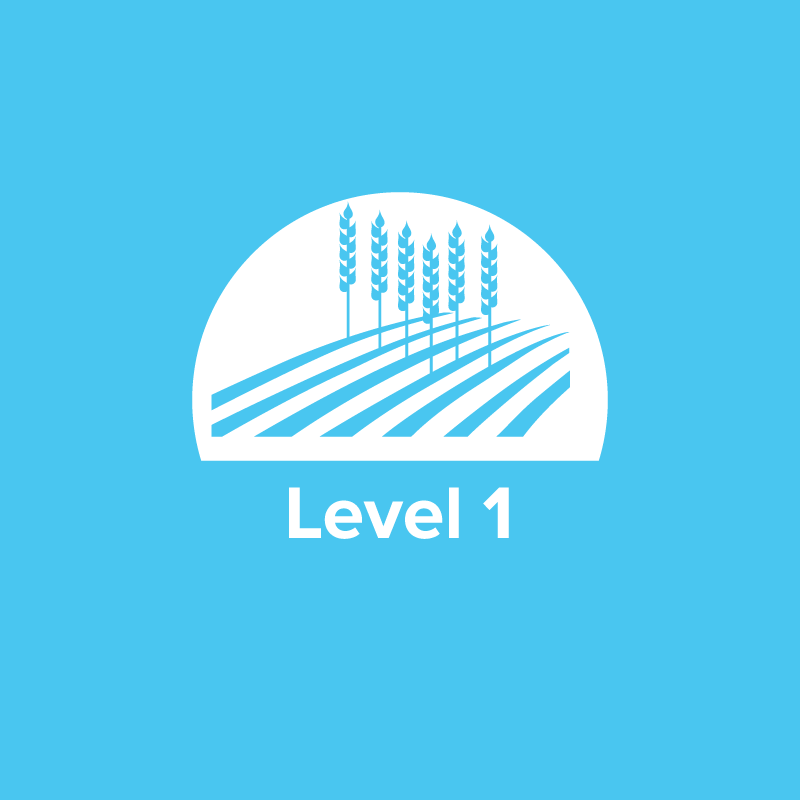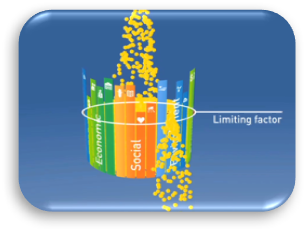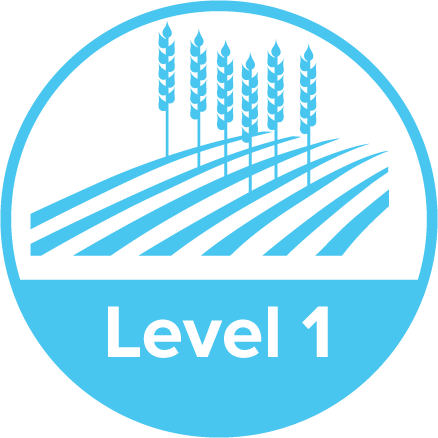Journey 2050 Lesson 1: Sustainable Agriculture (Grades 6-8)
Students will explore the core question, “How will we sustainably feed nearly 10 billion people by the year 2050?” as they discover what sustainable agriculture is and how it is critical to securing a stable food supply and future for a growing population.

Background
Lesson Activities
Recommended Companion Resources
Credits
Author
Lindsey Verhaeghe, Andrea Gardner, Debra Spielmaker, and Sara Hunt | National Center for Agricultural Literacy (NCAL) and Nutrien
Acknowledgements
The Journey 2050 program was originally developed by Nutrien in collaboration with Calgary Stampede, Alberta Canola Producers Commission, Nutrients for Life Foundation, and Agriculture in the Classroom Canada. Authors and contributors were drawn from each of these organizations under the direction of Lindsey Verhaeghe (Nutrien) and Robyn Kurbel (Calgary Stampede.) The lessons were updated and revised in 2017 and again in 2022 with contributions from the original J2050 Steering Committee, the National Center for Agricultural Literacy, and the National Agriculture in the Classroom Organization.
Sources
- http://www.economist.com/node/18200702
- Sustainable Development Network Solutions (2013). Solutions for Sustainable Agriculture and Food Systems http://unsdsn.org/mwg-internal/de5fs23hu73ds/progress?id=EHV3NQH3C4-PP-EivDwXY4i2HzIjIWty8lBnkNioco0,
- http://www.fao.org/mwg-internal/de5fs23hu73ds/progress?id=HXecPI0p3XpJtFbAsjLRZd3G4ZjPgUW5N3PqtZYwwio
- http://waterfortheworld.net/index.php?id=12
- http://www.un.org/sustainabledevelopment/sustainable-development-goals/
- Sustainable Development Network Solutions (2013). Solutions for Sustainable Agriculture and Food Systems http://unsdsn.org/mwg-internal/de5fs23hu73ds/progress?id=EHV3NQH3C4-PP-EivDwXY4i2HzIjIWty8lBnkNioco0,
- https://www.un.org/sustainabledevelopment/poverty/
- https://www.wfp.org/stories/5-facts-about-food-waste-and-hunger#:~:text=1, and http://www.un.org/waterforlifedecade/food_security.shtml
- https://irp-cdn.multiscreensite.com/be6d1d56/files/uploaded/TG07-Agriculture-Report-WEB.pdf
- http://www.economist.com/node/18200702
- http://www.worldfooddayusa.org/food_waste_the_facts
- http://www.un.org/en/globalissues/briefingpapers/population/vitalstats.shtml
- Sustainable Development Network Solutions (2013). Solutions for Sustainable Agriculture and Food Systems http://unsdsn.org/mwg-internal/de5fs23hu73ds/progress?id=EHV3NQH3C4-PP-EivDwXY4i2HzIjIWty8lBnkNioco0
Standards
Indiana Content Area Standards
-
Social Studies. Grade 6: Economics: Standard 4
Students examine the influence of physical and cultural factors upon the economic systems of countries in Europe and the Americas.
- 6.4.9 Economics: Explain how saving and investing help increase productivity and economic growth and compare and contrast individual saving and investing options.
-
English Language Arts.Grade 6.RV.1
Acquire and use accurately grade-level appropriate general academic and content-specific words and phrases; gather vocabulary knowledge when considering a word or phrase important to comprehension or expression.
- Vocabulary in Literature and Nonfiction Texts.6.RV.3.2: Determine the meaning of words and phrases as they are used in a nonfiction text, including figurative, connotative, and technical meanings.
-
English Language Arts.Grade 6.SL.1
Listen actively and adjust the use of spoken language (e.g., conventions, style, vocabulary) to communicate effectively with a variety of audiences and for different purposes.
- Comprehension.6.SL.3.1: Interpret information presented in diverse media and formats (e.g., visually, quantitatively, orally) and explain how it contributes to a topic, text, or issue under study.
- Discussion and Collaboration.6.SL.2.2: Elaborate and reflect on ideas under discussion by identifying specific evidence from materials under study and other resources.
-
English Language Arts.Grade 7.RV.1
Acquire and use accurately grade-appropriate general academic and content-specific words and phrases; gather vocabulary knowledge when considering a word or phrase important to comprehension or expression.
- Vocabulary in Literature and Nonfiction Texts.7.RV.3.2: Determine the meaning of words and phrases as they are used in a nonfiction text, including figurative, connotative, and technical meanings; analyze the impact of a specific word choice on meaning and tone.
-
English Language Arts.Grade 7.SL.1
Listen actively and adjust the use of spoken language (e.g., conventions, style, vocabulary) to communicate effectively with a variety of audiences and for different purposes.
- Comprehension.7.SL.3.1: Analyze the main ideas and supporting details presented in diverse media and formats (e.g., visually, quantitatively, orally) and explain how the ideas clarify a topic, text, or issue under study.
- Discussion and Collaboration.7.SL.2.1: Engage effectively in a range of collaborative discussions (e.g., one-on-one, in groups, and teacher-led) on grade- appropriate topics, texts, and issues, building on others ideas and expressing personal ideas clearly.
- Discussion and Collaboration.7.SL.2.2: Investigate and reflect on ideas under discussion by identifying specific evidence from materials under study and other resources.
-
English Language Arts.Grade 8.RV.1
Acquire and use accurately grade-appropriate general academic and content-specific words and phrases; gather vocabulary knowledge when considering a word or phrase important to comprehension or expression.
- Vocabulary in Literature and Nonfiction Texts.8.RV.3.2: Determine the meaning of words and phrases as they are used in a nonfiction text, including figurative, connotative, and technical meanings; analyze the impact of specific word choices on meaning and tone, including analogies or allusions to other texts.
-
English Language Arts.Grade 8.SL.1
Listen actively and adjust the use of spoken language (e.g., conventions, style, vocabulary) to communicate effectively with a variety of audiences and for different purposes.
- Comprehension.8.SL.3.1: Analyze the purpose of information presented in diverse media and formats (e.g., visually, quantitatively, orally) and evaluate the motives (e.g., social, commercial, political) behind its presentation.
- Discussion and Collaboration.8.SL.2.1: Engage effectively in a range of collaborative discussions (e.g., one-on-one, in groups, and teacher-led) on grade- appropriate topics, texts, and issues, building on others ideas and expressing personal ideas clearly.
- Discussion and Collaboration.8.SL.2.2: Examine, analyze, and reflect on ideas under discussion by identifying specific evidence from materials under study and other resources.
-
Social Studies. Grade 6: History: Standard 1
Students explore the key historic movements, events, and figures that contributed to the development of modern Europe and America from early civilizations through modern times by examining religious institutions, trade and cultural interactions, political institutions, and technological developments.
- 6.1.16 Modern Era: 1700 AD to Present: Discuss the benefits and challenges related to the development of a highly technological society.
 The economic component of sustainability is about earning money—creating jobs and incomes to support the national and local community. The social element encompasses things like food, education, medical care and infrastructure, including the roads used to transport food from the farm to your plate. And finally, there are environmental needs to consider. Soil quality needs to be maintained, habitats need protection, water must be conserved, and we need to protect our atmosphere by keeping greenhouse gas emissions to a minimum.
The economic component of sustainability is about earning money—creating jobs and incomes to support the national and local community. The social element encompasses things like food, education, medical care and infrastructure, including the roads used to transport food from the farm to your plate. And finally, there are environmental needs to consider. Soil quality needs to be maintained, habitats need protection, water must be conserved, and we need to protect our atmosphere by keeping greenhouse gas emissions to a minimum.